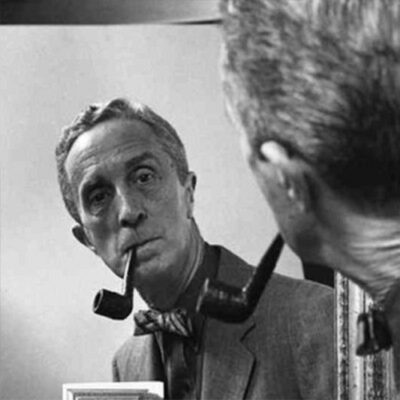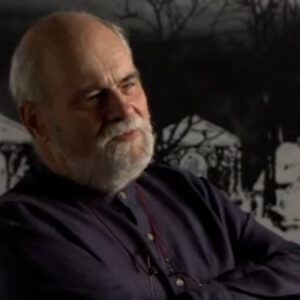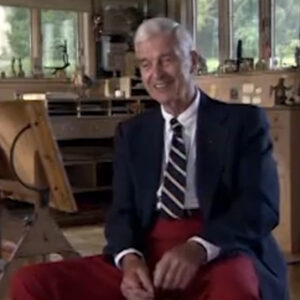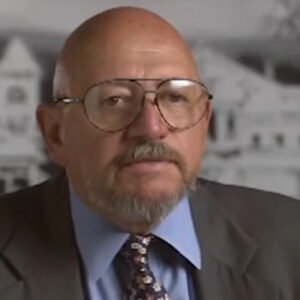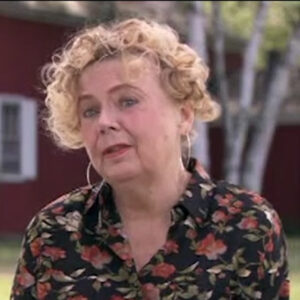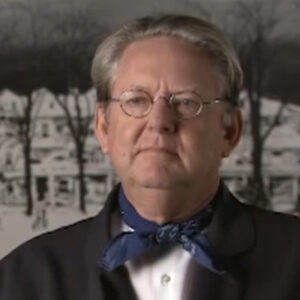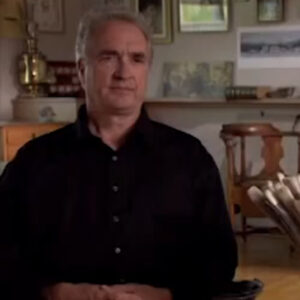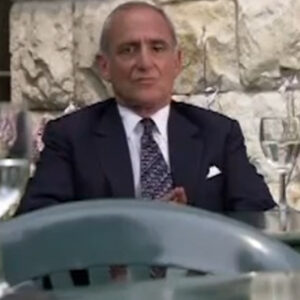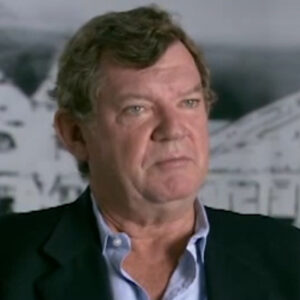Speaker Action with Rockwell or, you know, when did you start, like. For how long?
Speaker I started liking Norman Rockwell when I was a little kid and I because my grandmother subscribed to the Saturday Evening Post and she was the only person in our family who subscribed to magazines. And we’d go out to visit her at her farm on Sundays. And our occupation was my grandmother and me to sit on the couch and look at the picture magazines for the week together. And I grew up loving Norman Rockwell and loving all those illustrators who did the post and being intrigued by the pictures in the same way that you’re intrigued by pictures in a storybook. When you’re a kid, you want to look at every single detail. And that’s one of the things Rockwell allows you to do. And when I went away to college, my grandmother ran out and bought me the giant Norman Rockwell coffee table book, which had just come out as a gift. So I think I was probably the only legitimate art historian, whoever went away to college to study the history of art. Clutching an 80 pound Norman Rockwell book. So this has been sort of both a joy and a burden ever since, a burden in the sense that I really loved. Rockwell. And realism and hyper realism and made up realism and nostalgic realism and all that kind of thing. In an era at least what I was studying art history when it was Harold Rosenberg and Clement Greenberg and the flatness of the picture plane and the great existential struggle of man versus painting, that was what you were supposed to be interested in. And I never was.
Speaker Well, people. Yes. Yes.
Speaker Know we need to redo.
Speaker So wrong, people snicker at Rockwell really kind of, don’t they? I mean, why is that?
Speaker Well, I think in part because Rockwell seems so easy and modern art was supposed to be so incredibly difficult. It was supposed to be an acid test of who was a member of the intelligentsia and who wasn’t. I mean, this is like discerning the difference between trailer trash and the Ivy League. That was Rockwell.
Speaker Was the test also a question of what is art?
Speaker I guess I don’t know so much that it’s what is art so much as it is what is class? I mean, clearly, Leonardo da Vinci didn’t believe that art was something that was meant to be.
Speaker I guess the proper word isn’t puzzlement, but something that you had to spend the rest of your life worrying about. I mean, it was fine for art to picture something in the Renaissance and it was fine for art to picture something just about every era in our time until the modern movement came along. And Kandinsky said he’d rather see points in lines and planes than ladies and puppy dogs. So this is a very new and modern phenomenon, but it’s become a kind of way or it was for a brief moment, a kind of way of separating off ordinary taste from elite taste. Rockwell was associated with Rockwell, was associated with experiences that we’ve all had, experiences of having a soda after a prom or worrying about your son who was in the army and not about space or flatness or issues of that nature. And I’ve always said to myself, well, I mean, it’s fine to worry about space and flatness, but that’s never why I went to look at a picture in the first place. Never.
Speaker What was the.
Speaker You’re sorry. It’s how we live. Yeah.
Speaker Last month, we were this high definition camera picks up everything. So I go back.
Speaker Yes, I think there’s just one. God.
Speaker Good God. If we have to come again to say cut. It was very distracting to start talking in the middle of the interview. I don’t know what’s going on.
Speaker I thought perhaps the building was on fire. Fire on the crowd. OK. What led you to write a book about Rockwell?
Speaker I think I wrote a book about Rockwell because my exasperation with this. Division between modernism and the rest of human taste had had just reached a kind of crescendo. And additionally, I’d been doing a lot of research on Walt Disney and I think in some ways that empowered me. Most Americans, even if they don’t like the Disney Corporation and all its works and palms, seem pretty happy with the idea that Walt Disney was an important creative figure in American life. And he made Boodles of money and he’s a big part of the GNP today, etc.. And in a funny way, Disney and Norman Rockwell are a lot alike. They both seem to. Seemed to vend a kind of nostalgic look at the American past, perhaps a kind of sweetness about them both. And I think maybe it was working on Disney. That just empowered me to say for the first time. Well, you know, I’ve always liked this kind of stuff. I like Disney probably because of The Apprentice ship. I served at my grandmother’s knee with Norman Rockwell. I think I’ll just write this book.
Speaker Dave Rockwell, The Real America or what?
Speaker It’s you know, it’s very hard to say if anybody paints the real America. The more I got into Norman Rockwell, the more I confronted this issue of does he make it all up or was it there in some emotional way? Rockwell paints an emotional truth, and that is he’s a city boy from New York who clearly did not like that place in many ways. And I think what he didn’t like about it was a kind of sense of emotional violence that robbed him of a childhood. You don’t get a sense when you read Norman Rockwell’s autobiography that he had a kind of idyllic barefoot boy with cheak of tan upbringing. And so for many years, for maybe the first 15 years of his career, he kind of created a mythical, wonderful land of mischievous boys and dogs. Usually that had one brown eye patch. And it is that Fakher, is it real? Well, you have to ask yourself. I mean, Booth Tarkington created that same kind of world in a sense, that was a world that magazine fiction writers of this period were crazy about. If you go back and look at the paintings of somebody like Robert, Robert, Ari, Robert Henry, the great American realist, that’s a world that he was interested in to this wonderful world of childhood innocence and exuberance.
Speaker Is it a fake or is it what Americans were aspiring to in some ways after the turn of the century, had they felt a loss of innocence that they were trying to regain through the use of art? I think that’s an open question. Emotionally, this stuff is very real.
Speaker Let’s talk about Rockwells trials. Tell me about how he grew up.
Speaker Well, you would think that he probably grew up on a farm somewhere in the Midwest, but he didn’t. He. He grew up in New York City. Born there. Grew up in boarding houses in and around New Rochelle in the suburbs of New York. Came into the city to study art.
Speaker It’s only when he’s a grown up man that he begins to make a series of strategic escapes. Some of them to Paris, which many of his generation did. But in his case, to places like Arlington, Vermont, and ultimately to Stockbridge, Massachusetts. Those are kind of atypical escapes other artists of Norman Rockwell’s generation when they felt the need to leave behind the pressure. So the city tended to go to Taos and Santa Fe or to Woodstock or to old Lyme, Connecticut or someplace like that. Rockwell first goes to places where other illustrators live, like New Rochelle. And then he goes to places like Stockbridge, Massachusetts, which really don’t have an art tradition at all, but have a kind of connection with the colonial world, a kind of connection with American history. So from that point of view, he’s somewhat different from his contemporaries.
Speaker What we’re talking about is he wrote about his childhood memories of the city with very specific imagery. Can you just sense? Well, he talks say there’s one passage in his autobiography, which is a remarkably candid document in some ways in which he talks about seeing a drunken woman stumbling through a vacant lot.
Speaker And he just comments on it. He just puts that image down and then walks away from it. It’s really frightening in a way. It gives you a sense that to him, the city was kind of a horror.
Speaker What was it? Tell me a little bit more about that memory. What was the woman doing?
Speaker He just observed her as he observed so often in his own art. He sees her screaming as she stumbles through a lot, screaming at someone else as I remember it anyway. And there’s a kind of violence attached to that image that you’re never, ever going to see a Norman Rockwell’s art until he’s an old man and is deeply moved by the American civil rights movement. And all of a sudden, suddenly that violence comes to the surface again. And he avoided violence, absolutely stayed away from anything that would disrupt his pictures. Even his paintings are always in a kind of perfect balance that he works out so carefully beforehand through the use of photography, through the use of placing figures. If you posed for Norman Rockwell, he would oftentimes build a framework to hold your feet, for example, and your arms and your elbows so that you were quite literally locked into this. Position so that perfection would reign so that there was no danger of the intrusion of violence. I think in many ways all of Rockwell’s art until the 1960s is running away from whatever it is he saw in that vacant lot was going back to that image.
Speaker I think you describe it as a woman having a man with an umbrella.
Speaker I just need to say that the woman stumbles through a vacant lot, hitting a man with an umbrella. It’s this other ultimate disorder. Rockwells umbrellas are always very carefully furled. His characters always carry them in a very genteel fashion over their arms. They’re their props. They’re never used in a violent fashion. They’re always used to direct your attention to what it is you’re supposed to be looking at in the picture is a slope once or sad wants to it.
Speaker He admitted that a train kind of the world as he would like it to be.
Speaker Yeah. And of course, all art is a way of ordering experience, isn’t it? But Norman Rockwell ordered experience more than most people did.
Speaker And it’s fascinating to me that the era in which he was most excoriated is the era in which ordering experience was not what you were supposed to do. You were supposed to unleash experience visibly in a work of art.
Speaker He really came a cropper during the 1950s when the abstract expressionists were in ascendancy in the New York art market and when showing one’s emotion and one’s bodily movements visible visibly on canvas, what was what you were supposed to do as a painter? And here’s Rockwell up in Stockbridge, Massachusetts, posing little boys and girls with plywood props under their feet so they won’t move. I mean, there’s a tremendous difference between Jackson Pollock out there performing a dance on his canvases and Rockwell making sure nothing moves at all.
Speaker Well, you call it perfectionism. I mean, there are people who say, you know, it was utter lack of imagination. You know, we had to paint from us. You know, reality couldn’t make it up.
Speaker Norman Rockwell made everything up. This man had tremendous imagination. We call him an illustrator, but we fail to make the distinction that we need to make between a text illustrator and a cover illustrator. A text illustrator really does. And Rockwell did this very seldom, and I don’t think very well a text illustrator reads a story and then decides what episodes need to be illustrated and what should be shown. Rockwell very rarely did that cover. Illustrator creates both the story and the picture. Nobody at the Saturday Evening Post sat down and said to Norman Rockwell, You will paint a boy and a dog or you will paint a girl lying in bed with a terrible sniffle who wasn’t able to go to her senior prom. Those are all ideas that Rockwell had to pull out of his own head and then say to himself, how is it best then to show this idea and what props will I need and what should the girl look like? He had a kind of idea in his mind always, of what the perfect face for a given idea would be and then would search his neighbors in Arlington and Stockbridge and stop people on the street and buttonhole them. He went to extraordinary lengths to match reality to his imagination. The story is told of one of his pictures of his young son posed in a New York central railroad dining car, worrying about what kind of a tip he should give the waiter and holding a comic book. And he went he talked to all the top brass at the New York Central. He auditioned railroad cars before he found the right one.
Speaker The same thing is true of one of his railroad station paintings where he quite literally looked at half the railroad stations in the United States before he made up his mind that this one matched the contents of his soul.
Speaker I mean, there is this continual theme it through his life of the struggle to do what he did very well. You know, that’s how story was tried. But in some sense, he wanted to do more to be a different kind of artist. I mean, well, I mean, he he acknowledged.
Speaker And why wouldn’t he? After all, it’s something to be proud of. That he was a great storyteller and not just a storyteller, a story writer, but he was doing so, particularly in the period of his maturity. When World War Two is over, the art market is taking off in New York. Art suddenly becoming a hot thing. And the question arises, is this Rockwell guy an artist or not? I mean, that must have been bedeviling for him because the very skill that he was best at conceiving stories that told you something about the world around you and about the emotional and physical properties of the world around you. I might say the physical properties became more and more interesting to him as the years went by, the textures of things. If you look at early Norman Rockwell’s, everything tends to be the same texture. You look at late Norman Rockwell’s, he’s he’s very interested in differentiating between one kind of material object and the other. How galling it must have been for him after a career of perfecting this craft of his to come to the end, what he thinks is the end of a long life and discover that those skills don’t seem to be needed at all or not wanted at all. So I think he did have a crisis in the late 40s, in the 1950s and in the early 60s about, you know. Am I worth anything? Have I been doing something that’s worthwhile? And this is, of course, exacerbated by his worsening relations with the post, which is falling apart at this point. When he goes to Look magazine finally in the 1960s and is challenged really by look not just to makeup sweet stories about America, but to look at it as it really is, his work undergoes a radical kind of change.
Speaker Do you think it was look up prompt about or.
Speaker Well, I think it’s combination. It’s a combination of working for a newsmagazine that’s really interested in Rockwell as a reporter on the totality of the American scene, not just one side of it. I think it’s his growing friendship with people like Erick Erickson who are living in Stockbridge, where he and his wife have moved in the early 1950s, who challenge him to think about a broader picture of the world, not just the world, as he’d like it to be, not just a corrective to a life that we imagined to be perfect, but certainly contained its own turbulences. This is a man, after all, who was married three times for that era. That’s a remarkable number of marriages. Yeah, I think Ericsson is a major influence.
Speaker Well, let’s back up a little bit. I mean, his personal life, Rockwell didn’t fit his public image either, right?
Speaker Not quite. I’m sorry. Yeah, there’s a there’s a real difference between the idea of Norman Rockwell as this bland, skinny guy with a pipe and a perpetual smile. And the real Rockwell, who is a kind of troubled person, I wouldn’t say tortured, but certainly troubled. I’m always both moved and appalled by stories that his children published about Norman Rockwell’s Christmases, for example, where they would come down to see their presence under the tree. And it was with the greatest reluctance that their father participated in this falderal and then very quickly left. He had to get back to the studio and at an early age, the kids realized that their mother had done all the Christmas preparations and their father was obsessed by work. Or you hear the story of Rockwell waking up at three o’clock in the morning at the beginning of World War Two, just obsessed by Franklin Roosevelt’s concept of the four freedoms and can’t get back to sleep and is literally driven to create something to match the eloquence of Franklin Roosevelt’s words. This is a man who is perpetually on the edge. He, in a way, I suppose it has to do with meeting deadlines. The whole of July, for example, he’s working on winter subject matter. It’s got to be done. And there’s got to be an inspiration for it.
Speaker He talks about painting a man leaning against a lamp post when he can’t think of anything else and he just draws him over and over again and then draws what comes next and hopes that will give him an idea. But this is a person who’s driven by his own work and driven by its deadlines, by its problems, by its difficulties. And and since it’s all coming out of him by his own failure of imagination and he was for real friends of the prevalent insecurity of his work.
Speaker The the usual biographic statement about Rockwell is that he moves to Stockbridge for the sake of his second wife, who entered treatment there for alcoholism. But in fact, yes, Rockwell was ridden throughout his life by depressive episodes that he only began treating in earnest when they moved to Stockbridge. Certainly, I’m sure, exacerbated by the insecurities of his work. Here’s somebody who’s also working without a net.
Speaker If you’re a painter in New York, and that’s always the, I think the correlative against which Rockwell judged himself. So you have a bad day. You get rid of the evidence. That never happens with Rockwell winds up on the cover of the Saturday Evening Post. I mean, he’s really flying without a net. Most of the time. And if he’s gonna maintain his position as the Post’s most successful cover artist, he has to pump it out over and over and over again.
Speaker But I see somebody from the traditional art world in the way he goes initially to Arlington, the company of other illustrators like himself. Tell me about that.
Speaker Well, what were Norman Rockwell’s options in a place as a place to live? He does shun the traditional watering holes of the art world. But then again, he grows up and he’s born in 94. He grows up at the turning of the century. He enters not the art students league, to learn how to be a great painter and the manner of the ashcan school.
Speaker He goes straight to the illustrator classes. So where it from the beginning? This is, I suppose, the great watershed. Isn’t it, at this era between who’s a commercial guy and who’s a genius? And Rockwell picked the wrong side of the wrong side of the great divide to operate on. And he was handicapped from then on. He also absorbed lots of the values of the illustrator. Those values being hard work, meeting a deadline, not necessarily being appalled if the editors suggested that something was wrong with your work. I mean, can you imagine de Kooning having a conversation with a gallery director said, you know, I think that green over in the left hand corner ought to be taken out of.
Speaker That conversation would not have happened. And it’s a conversation that Rockwell had practically every week of his life. Many certainly enjoy the company of other illustrators, too, in Arlington. Well, I think he enjoyed the professional chit chat, too, very much.
Speaker The notion that, yes, we’re all us boys have a deadline to meet. And how do you get started and when are dry? How do you move forward?
Speaker I mean, they were still coming out of golden age of illustration, right? I mean, when we first started I mean, do you think that illustration was already was that its heyday or was it going down?
Speaker The status of illustration as Norman Rockwell was starting out is a very difficult subject.
Speaker In some senses, these guys were in tremendous demand. They’re the successors of Howard Pyle and CYF and the Post, among others, and certainly advertisers like Coca-Cola and tire companies and things need their work all the time. On the other hand, it is very clear from the day Norman Rockwell began illustrating that the photograph was the wave of the future. And so the illustrators developed this kind of competition with the photograph, which is a fascinating episode in American illustration. If you look at J.C. Lione Dekker, who was one of Rockwell’s neighbors in New Rochelle and somebody he really admired and probably the greatest 20th century illustrator. You see him taking enormous freedom with reality. He doesn’t duplicate the things he sees around him. There’s a very abstract quality to most of life. Dikkers work, but he’s the past and the future is this photograph. People like Edward Steichen coming in and working for major corporations and doing photographic ads for magazines. And so there was this this movement in the direction of photographic realism to, in a sense, counter the use of the photograph. And I think one of the most interesting passages in Rockwell’s autobiography concerns the whole issue of hiding the fact that you used to photograph for many years illustrators if they came to visit one another’s studios. I mean, there’d be this frantic scrambling to knock on the door. Just a minute. Just a minute. And all the evidence of the use of photographs and enlargements of photographs and materials to project photographs onto a canvas. Those are all hidden away. It’s really not until World War Two that Rockwell is able to absolutely acknowledge and to show in a published sources like books about him and articles about him, that he, in fact used photographs as a tool. Now, that’s that’s kind of interesting in a way, because one of the things that art historians are always studying is the use of the photograph, a 19th century painting. And it was very widely used. Dellacqua had albums of nudes, for example, that he used all the time. And the French would just say, oh, it’s an aide memoire and move on, you know? But I think it becomes an issue with American illustrators in the early 20th century.
Speaker Just briefly describe how, Rockwell, the work process, know how he look projection.
Speaker Well, the mature work for us. Yes, for Norman Rockwell is kind of complicated. First he gets the idea, then he starts making little bitty sketches of what the idea might be like. Meanwhile, he’s searching around for models. He has an assistant who then will photograph the model in the position that he wants.
Speaker And if he can do it, he’ll photograph the model with the background he wants as well. Sometimes constructing bits and pieces of a diner or sometimes, you know, a corner of a living room or something in his own studio. And we have a lot of these photographs. So we know what they look like. And they’re often, you know, 25 or 30 alternate versions of how this subject might look. And then a further process of sketching to see how things might change ever so slightly or how color. Oftentimes a color study comes in then because these photographs are taken in black and white. How will color alter this composition? And one of the final steps is then to project the photograph with a photographic device onto a large sheet of canvas and to quite literally trace it. Sometimes Rockwell does that or in his later years, sometimes an assistant does that. And these give you sort of guidelines against which you can then work when you’re completing the canvas. But of course, you know, all the photographs in the world don’t really solve the artistic problem, which is the invention itself, the initial invention problems like the relationship of one color to another. And I think Rockwell’s color is interesting and extraordinary, especially his use of warm colors. Use of reds in his canvases is wonderful, just to light up a little part of the canvas. He’s often very daring. You know, you’ll see no red in the canvas and all of a sudden you’ll notice a little cushion under the the tush of the principal character. And you say to yourself, this picture would have been really boring and dull, but somehow that red just makes the whole thing pop. So there’s a use of photography as a help in. Painting. I wouldn’t think it’s any different from the use of photography for somebody like Chuck Close, except that maybe closest commenting on the photograph as well as using it. Whereas Rockwell doesn’t seem to want to comment on his tools.
Speaker Now, why Rockwell Lensman son was working almost as a movie director. He was creating a scene.
Speaker Yeah. I mean, this is a lot like Hollywood. And I think one of the things that we often overlook when we think about Norman Rockwell is his involvement with Hollywood. There are a few overt Hollywood pictures. One of my favorites is a Gary Cooper being made up. There’s a makeup man sitting directly opposite. Cooper need a knee and Cooper’s in full cowboy regalia and the man’s painting his lips. And it’s a wonderfully delicious picture in in any in any event, it talks about the falsity of Hollywood. It talks about the fact that our cowboy heroes have to be very carefully painted. But it also, in a sense, talks about art and how what that makeup man is doing isn’t very different from what, in fact, Norman Rockwell does, which is to set his scene and to paint it very carefully and to create an illusion. He spent lots of time in Hollywood. He was an extra in the movie Stagecoach.
Speaker In addition to doing the publicity paintings for it, he met his second wife in Hollywood when he was visiting there. And I’m always intrigued as I was doing research in Rockwell to see how many times of the year in an average year he would somehow or another contrive to be in Hollywood. And there is something very theatrical about these pictures, the involvement with photography, the setting of the scenes, the choosing of the scenes. Maybe that’s the best way to look at Norman Rockwell. The movies are our new 20th century art. They’ve really transformed our vision of the world. And Rockwell is very much a part, it seems to me, of that movement. Maybe you could call it the Andy Hardy School of Art in some respects, but it’s very much tied up with Hollywood sensibilities, even you sequential imagery, right? Like a storm movie. Rockwell often used what we would nowadays call a storyboard, particularly in the 1940s and 50s. You’ll see in the simplest way. Some of his very earliest pictures for Country Gentleman and some of the other magazines he worked for in the teens of the century and in the 20s will show two boys sneaking a smoke behind a fence and then the next picture will show what happens to them as a result.
Speaker They’ve both turned green and are about to throw up. He continues that all the time in works like you’ll see a family going on vacation, all happy and excited and then coming home incredibly frazzled and in the next scene. And then he finally starts to combine all of these scenes in one cover. So you’ll see that one of my favorites is The Day in the Life of a little girl. And she wakes up in the morning and she goes swimming and she meets a boy and they they kiss and she goes to a birthday party and he brings her home. And then there’s a comparable picture, the day in the life of a little boy and another one that’s a favorite of telephone companies everywhere to put on the front cover of your phone book. And that’s a picture called Gossip’s, where it starts in the upper left hand corner and somebody phones somebody else up and tells them something. And then you follow the excitement as this news works its way through the community until finally the rumor reaches the person who it’s about. It’s just a wonderful thing. And again, it’s very cinematic in the sense that it incorporates time and change into the picture as though they were frames in a motion picture that his post covers in a way.
Speaker Were they the precursor of the role, what television now plays for or something else or calling the nation’s stories?
Speaker There is a kind of muted topicality about Norman Rockwell’s work that is very similar to television. When we read headlines about crime and violence, for example, we then see it represented for us on television, but generally in a kinder, gentler or at least more artistic form. If we hear about single parent families, for example, and read about that, then suddenly on television, everything is a single parent family represented in the most cheerful way possible. Generally, these are not depressed, horrible people beating their children by night. These are comedies. There is something about Norman Rockwell that’s very much like television. It’s yes, it’s it’s about our lives, but it’s about a slightly skewed version of our lives that is kinder and gentler.
Speaker You wrote that he created a national identity that overcame sort of a different immigrant ethnic group identities. And you said something like that.
Speaker Rockwells seems at first blush not to be very interested in ethnicities because we don’t see things like, you know, Italian family picnics or ethnic costume. And we hardly ever until the 1960s see black people in Norman Rockwell’s work. And we might be able to account for the latter by the fact that the Saturday Evening Post made that part of their editorial policy. They actually told Norman Rockwell that they didn’t want him to use black people on his covers unless they were in a subservient position. So you occasionally will see a porter or a servant or a waiter in Iraq. Well, picture he he does present a kind of homogeneous version of America in which everything is pretty decent. However, there are no divisions. He doesn’t give you anybody who might suggest anything divisive. Everybody seems to be scraping along just fine. And he gives you because he went out and looked for faces, I think a kind of pungent sense of some kinds of differences. There are always some intensely red headed little people in his pictures are intensely dark eyed people. They don’t all look like a race of potatoes who all look quite the same. Yet they’re all white people and they all seem to be members of a kind of comfortable lower to middle middle class. And they all seem to be quite happy.
Speaker The one with the other. But I mean, did he create kind of a unifying vision or dream of America?
Speaker I think this is the notion of a unifying dream or vision of America. And Norman Rockwell’s work is is partly a result of our looking at Norman Rockwell’s work today, that when we look back on Norman Rockwell’s work from the perspective of a culture in which we seem to be so divisive that everybody will eventually sue everybody else for something, Rockwell’s world seems to us to be quite lovely. And I did like I’m not so sure that that’s the way it was meant to be.
Speaker Salesmen go out in Norman Rockwell’s art on the road. And if we look at one of Rockwell salesman pictures today and there are a lot of them, we can just say, oh, isn’t that cute? There he is, propped up in bed reading a magazine or there he is in an airplane seat fudging his expense account. And it seems to us like part of another era. And we don’t have too much of a stake in it. And so it seems, you know, kind of pleasant and nice to us. I’m not so sure that if you looked at that picture from the standpoint of a world in which there really are a traveling salesman and a period in which Arthur Miller, among others, are exploring that kind of rootless, economically driven life, that we would see those pictures in quite the same way they’re tragedies in some sense.
Speaker Yeah, I mean, I think if you look closely at those pictures, you can see that mean you see the weariness that these people are tired, that they’re frazzled, that they’re overweight, that people who tend to live a life in public where they have to be always affable in private, can’t maintain that mask. That’s pretty much sometimes what Edward Hopper saying in his pictures of lonely people caught by themselves when they’re not putting on a show for a group. There’s a tragedy in these works.
Speaker So if you look closely at Rockwell, it’s not a perfect world.
Speaker No. And even his I know what Rockwell is a little boys and little girls. I don’t live in a perfect world either. I mean, there’s always a sheriff to chase them away from the swimming hole. The little boy and the little girl don’t instantly fall in love when you see them on the magazine cover. Little kids run away from home, for heaven’s sakes, with bandanas over their shoulders. A little girl sits and looks at herself in a mirror and compares herself to a movie magazine pictured that she has propped up on the floor and wonders if she’s going to be pretty enough to compete in this world. These are these are not all comfortable feelings.
Speaker It’s up as a sort of subtext in Rockwell, part of his appeal.
Speaker I don’t know that we oftentimes see the subtext in Rockwell’s work. I don’t think that particularly his critics have looked hard enough at these works, which always reward looking hard. One of one of my favorite Rockwells is a picture of the kind of weather beaten farmer sitting on the running board of his truck with his young son and the son’s dog. And the son is going away to college. And the only way to understand that picture is to look at everything in it. You look at the son’s awkward brand new clothes, which could be made out of cardboard. They’re so stiff as opposed to the father’s work worn denims. And you look at the father fingering his his hat and you look at the line of sunburn on his brow and you notice where the spots of red are in the picture and they’re kind of little ones scattered around. And then all of a sudden on one side of the picture, a red flag that they’re going to have to use to stop the train to send the son away. It’s only when you collectively look at all those details that what seems to be a kind of perky picture becomes terribly sad. You have to stop this life and that boy has to go away from his father. And his father’s going to feel terrible for a long time. And you could cry, but I don’t know that when you first look at the picture, you say that you say, gee, that’s a needle Ford truck. And, gee, what a nice dot. Of course, the dog is the key to what this picture is about. The dog is about to have a nervous breakdown. It’s leaning its head, the boy’s leg, and it knows what’s going on. Even if we don’t. And it’s that process of cumulative looking that’s so important. And Rockwell’s work, you can’t walk up to it in the same way that you can walk up to the for the average abstract picture, for example. And I don’t know that you you get much of a return if you looked at a black square and a green one for two or three hours. On the other hand, you can’t get a lot out of looking at Rockwell’s details and how those details are painted, what colors he chooses for them and what positions he chooses for them in a work. The FT in Norman Rockwell always intrigued me. If you look at his average post cover, the thing you notice is that hardly ever is anybody cut off so that you only see a part of their body. They’re almost always complete figures and they’re almost always grounded in the picture by huge feet. Me, Rosie the Riveter has some of the greatest, the greatest pair of feet in American art. That just has enormous feet. And one of the ways that Rockwell kind of both pokes fun at her and tells us something about her is that she’s got a great big pair of men’s loafers on and they’re very prominent within the picture. His bodies tend to fall short and a little bit as you move up, which makes these feet very big. But it also helps to make you aware in the picture of where down is. It makes you very much aware always of how gravity pulls that a figure. And I kind of like that. You say you don’t quite know that happens in the pictures, but you sense it that these people are grounded. And oftentimes the shoes tell you interesting things. You know, if you’re down at the heels, he’s he’s very careful to show you that the shoe is worn and that the soul is coming away. Or if somebody has come home from work, they always put slippers on. And Norman Rockwell’s pictures. So you can tell that this is a leisure time pursuit they’re engaged in, but feet are enormously important for him also. Rockwell had very long, long, long feet and oftentimes so do his characters. They’re sort of almost unnaturally long.
Speaker They’re they’re the Rockwell in his fingers and the feet on the marriage license of the clerk.
Speaker I tell you what, in the marriage license that they tell you something, the shoes, the feet tell you something kind of interesting. The girl is so delicate and so tiny. Her tininess is emphasized by the fact that she has to rise up on tiptoes in her high heels, which are of a very light color, to be able to reach over the top of the counter to sign her marriage license. And the old man, the clerk who seems utterly indifferent to this story of young love that’s going on on the other side of the counter, is wearing his rubbers. He’s eager to go home. It’s time to leave. And then if you check the clock. Yes, indeed. They’ve just come in under the wire. So it’s one of those details that makes the story.
Speaker I want to go back to his move to Arlington and what that signified. Like I’m him do his work change at that point?
Speaker Well, was one of the things that happened to Norman Rockwell and Arlington was then he had an endless supply of interesting faces, I think, to work with. And there seems to be an emotional deepening of his work in Arlington. I always think of the most important thing that Rockwell did in Arlington is the Four Freedoms series. And perhaps it was the fact that he was living in a community where the war touched individuals so strongly that helped him to develop that series. And certainly it’s the heart of the Willie Gillis series, which I think is one of the most interesting documents of the Second World War ever produced, because rather than dealing with great events and great people and great movements of people, this is not the movie top news. This is what happens to your son, your brother, your boyfriend when he goes off in the service. Willie Gillis is just an ordinary little guy. And Rockwell always makes him littler than everybody else in the picture around him. And he’s always got this wide eyed expression. And terrible things don’t happen to Willie. But the ordinary adventures of life happen at the same time that he’s connected to his hometown. If you look carefully at the Willie Gillis series, he’s always writing his name on things as though to assert who he is in this big world that he finds himself in. His mom sends him newspapers from home and circles things that he ought to read to connect him back to home. And I think there’s a poignance there that is just beyond telling. And people would write it if if a Willie cover didn’t appear at a regular interval to wonder what happened to Willie. Now, Americans weren’t any stupider in Rockwell’s era than they are in ours, but they accepted this fictional character as a real part of their lives during the Second World War and a way of understanding what was going on to their children. I Rockwells war pictures are wonderful. There’s one that sometimes called homecoming Marine. That’s a hard picture to figure out, to accept by looking very carefully. And it’s very detailed interior of a garage and a young man, a Marine in uniform, is sitting there surrounded by what seems to be relatives or a former employer. And there’s every generation of male possible in this garage. And then you see up on the wall a notation created by a clipping out of a newspaper about the battle of Iwo Jima in the Pacific theater and that this young man who’s now sitting in this garage safe in Arlington, has been a hero of that battle. And the boys holding a captured battle flag, and he’s very quietly talking about the war. And I can’t imagine anything. That’s a greater contrast to Joe Rosenthal’s famous photograph of the Marines raising the flag on Iwo Jima. Then this scene, which connects that distant place to what home is all about and a circle of talking and discussing and generations and utter peacefulness.
Speaker So Rockwell purposely avoided a reference to violence recently. It was a rosy cheeked view of a war.
Speaker Rockwell purposely avoided any reference to violence. The only picture that he did during World War Two that has a hint of violence about it is a war poster that he did early on in the war of a soldier tending a machine gun. That’s it. And even that shows doesn’t show the consequence of the use of this gun. It just shows a tired soldier a gun and then the picture ends. Other than that, what he is yearning for and what all these pictures seem to yearn for is the end of a conflict is the restoration of peace.
Speaker Was he doing that because of sold butter?
Speaker I don’t. I don’t think Rockwell tried to.
Speaker Talk about peace. Because he was hoping to sell more issues of the Saturday Evening Post. I think he talked about peace because he abhorred war. This is maybe the first expression of Norman Rockwell social conscience coming to the surface. Tell me about the four freedoms and the four freedoms are an interesting exercise also in peace there. They’re about peace, profoundly, freedom from fear. A mother and a father tucking in two little children in an attic bedroom while the father holds a newspaper that alludes to this distant and terrible war. There’s no war in this attic. The little girl’s doll falls on the floor. This is a home at peace. Rockwell worried, in fact, that maybe this picture was too smug. When the four freedoms were ultimately reproduced as posters for first war bonds and then ultimately reproduced as posters that were circulated in Europe, he worried that Europeans might think, given how badly they had suffered during the war, that he wasn’t aware enough of that. But again, these are pictures for an American audience. And this picture seems to me to be a fervent prayer that war never touches these children. Freedom from want a Thanksgiving dinner? Rockwell’s own family. His mother is the white haired lady in the foreground of the work, his own family having a Thanksgiving dinner. By our standards, this isn’t the most sumptuous Thanksgiving dinner in the world. There’s a fair to middling sized bird on the table. There are some celery in a glass. There’s a molded salad. But from the point of view, of course, of somebody going through the rationing experience in England. Let’s say this looks like the most gorgeous feast in the world. But again, it’s about peace. It’s about abundance. It’s about family life. It’s about the family circle together with nobody missing. Those paintings are about hopes and dreams. They’re very much. I think what Franklin Roosevelt meant.
Speaker The four freedoms to be about freedom from want in particular has really become a cultural icon. I mean, just freedom from want.
Speaker I think what surprised Norman Rockwell today, and I don’t know if he would be delighted about this, he was perhaps less satisfied by that picture than he was by any of them, because he did think in the long run that maybe he had been a little smug about Americans having the good things of life. But it’s the picture that people walk right up to at the Rockwell Museum, where the four freedoms are hung in their own little gallery and identify with so closely. And is it because of the turkey? Is it because we equate the good things in life, the good material things in life somehow with living the good life? I don’t think so. I think it’s because of that circle of generations that sits around that table that that represents an ideal we would like to see come true in our lives.
Speaker And other parallels with Rockwell on Christmas and the way in which somehow Rockwell and American Christmas become connected.
Speaker There are even picture books written about Rockwell’s Christmas, which is interesting given the fact that he kept Christmas so badly himself and was usually running around the house frantically in July, serving ice tea to people perspiring in Santa suits to try to get his Christmas covers finished. Rockwell’s Christmas. I find highly ambiguous. One of my favorite Rockwell Christmas pictures is sometimes called Drysdale’s Santa, and it’s the interior of a New York subway train. And there is an old man who really looks like he’s down on his luck, very tired, sitting in the foreground of the picture. And he’s clearly a department store Santa, and he has an expression of utter desolation on his face. And you see the whiskers sticking out of his pocket. And there’s a poster right on the wall behind him that invites you to come to Drysdale’s department store and see Santa and the Santa. And the poster is jolly and happy as this poor man is not. Little boy pops his head around the door carrying packages that say Drysdale’s all over them and sees the Santa whom presumably he’s just seen in the department store sitting on the seat. It’s both a commentary, in a way, and the commercial Christmas, where we go to the department store and see Santa and Santa is a fake. And it’s a commentary on the artificial jollity of the holiday all at once. A great deal was made of a Rockwell cover that the Post held off printing until right after Christmas of a little boy rummaging around in the bottom drawer of his father’s bureau and coming up with a Santa suit. And he has this just shocked expression on his. Face, but maybe they have Drysdale picture is more shocking in its own way because the child sees the artifice of Christmas and the old man is so obviously not the smiling Santa in the picture. There is a sense of the adult artifice that goes into this holiday as well, that the person who was the Saturday Evening Post is very important in the invention of American holiday iconography. And in the creation of holidays that we regard now as greeting card days. But that’s mainly the creation of J.C. Layendecker, again, whose Santas are unambiguously great, big, jolly happy sorts, almost all of Rockwells Santas. Don’t give that impression. There’s a picture that I that just creeps me out of Santa, a gigantic Santa holding a tiny little boy in the palm of his hand. And I’ve never been able to figure out what Rockwell meant by that picture. I mean, he could pop that little boy in his mouth and swallow it. It’s this tiny little figure standing on the hand of this enormous creature. I find it more frightening than anything else.
Speaker So, Rockwell, the ultimate mythmakers saying this isn’t real.
Speaker I think Rockwell, Christmas pictures are highly problematic, that maybe he’s not so much a myth maker as he is a teller of truths that we oftentimes don’t want to see, that we would much rather look at the picture and go, ho, ho, ho, and walk away. But do you think people see that? I mean, I don’t like it. I don’t think people see this in in Norman Rockwell’s work half as often as they should, or they wouldn’t be buying coffee table books that say a Norman Rockwell Christmas. That’s not the Christmas I want.
Speaker Yeah, I mean, Winter and Star.
Speaker I mean, winter and staff branches, brunches, you know, that’s Christmas to a lot of Americans.
Speaker Winter in Stockbridge, I think is maybe Norman Rockwell’s least difficult Christmas picture. We only know it’s Christmas, for one thing, by very subtle clues. There is a Christmas tree in an upstairs window. There is there’s a wreath in the picture. There’s a station wagon going down the street with a Christmas tree on the roof. It’s not full of jolly people. And Christmas time and ho, ho, ho. It’s a landscape and it’s a landscape that by the time Rockwell painted that picture, could have been Main Street, USA at Disney World. It smacks of small town values in an age of suburban ism and suggests a kind of nostalgia that most of the time really isn’t in a lot of Rockwell’s work. Here’s his Christmas. Pictures are not all difficult and problematic, but lots of them are. I’m thinking about the Chicago Railroad Station picture painted during the Second World War. And it’s a big crowd scene. And again, at first glance, you might not know it’s Christmas. And then you see that there are some garlands and crepe paper bills and things hung up above. And then as you look at the crowd more carefully, there’s a Santa seen from the rear. Kind of skinny Santa anon convincing Santa. And then the crowd is rushing out at you and you notice that a lot of them have packages under their arms. There’s a drunk in one corner of the picture who has a wreath over one arm and a tree, and the other is trying desperately to make his way through the crowd. But it’s really more of a homecoming picture. And I like the Christmas pictures that are about people coming home the best. There’s a picture called Homecoming that you, again, you don’t quite notice it’s Christmas, but you notice an emotional warmth. You see a boy from the back, whether he’s coming home from war or from college, you don’t know. And he has a suitcase in one hand, bulging underwear sticking out. And the other arm, he has five or six wrapped Christmas packages that you see from the rear. There’s a Christmas tree over in one corner of the picture. But what you most notice are all the family members lined up across the picture plane to envelop him in this great arc of love as he comes back to them, his mother ecstatically throwing her arms around him again, all ages and classes, little kids. Rockwell even put Grandma Moses in that picture to represent old age himself, ready to greet the boy. So the Santa pictures aren’t very satisfactory to me, but the people pictures are.
Speaker But this issue of how the viewer responds to Rockwell’s fascinating and what goes way beyond Christmas.
Speaker It does. Yes, it does. I mean, we go to many of these pictures with the expectation that because Rockwell is the great American cornpone, that everything is going to be sweet and lovely. And oftentimes we emblazon these things on ashtrays and notepaper and Christmas cards. And I think we go away and don’t think about it anymore. And it’s a great commentary on how we oftentimes don’t look at art, that it just becomes a kind of icon called Norman Rockwell. And we expect it to convey certain values, and it does.
Speaker But you would say he’s great because there’s more on the paintings than we give him credit for or.
Speaker Well, there’s more in the paintings than we give him credit for emotionally. But there’s also more in the pictures that is to be enjoyed on other levels. There are. There’s no better way to learn to appreciate the variance in the material world. The various essence of the material world. And to look at Iraq. Well, the difference between an umbrella and or a shoe, the difference between a face and a hat. The way these things feel, what they signify, their weight, their lack of weight. Those are all things that Rockwell is very concerned about that I think are are fascinating and interesting. It may just be that I’m a terrible American materialist who’s deeply involved in the things of this world. But that seems to me to be the most convincing part of Rockwell how things are in this finite world of ours.
Speaker That’s I call helped create how things are. And as they had an impact on the culture as well as.
Speaker Reflecting up.
Speaker I think that might be a great imponderable to talk about whether or not Rockwell has influenced the weight we give to the things of this world. But to go back to the notion of Rockwell as cinematic, one of the most interesting things that’s happened in American movies in the past 20 years or so is the loving attention the camera in the most ordinary movie gives to the set. You think about early motion pictures in which there’s virtually nothing on the set. There may be a prop, a gun, a Maltese Falcon. And let’s say that and the drama is enacted again in an almost bare environment versus almost any film nowadays where the camera moves over every possession in a given interior. That’s very Rockwell in that we use the motion picture camera to say something about the social the emotional condition of the people involved in this film before they ever open their mouths.
Speaker Some movie directors, and certainly Fehlberg, for one, have talked about directly using Rockwell imagery. And you talk about battles, right?
Speaker Well, Spielberg, this is Steven Spielberg was one of the great backers of the Norman Rockwell Museum in Stockbridge. And I think for a lot of good reasons, he’s also somebody who, more than anyone else, I think sees cracks open ordinariness like a nut frequently and finds something in it, finds the magic or the horror. For example, in an ordinary suburban tract house, in a film like E.T. where he opened the closet door and suddenly you’re in another dimension altogether, I think Spellberg sees oftentimes the lyricism or the horror of ordinary life situations. And I’m not suggesting that every Norman Rockwell picture is designed to expose the underbelly of American life. But in almost all of them, there is a lot more there than meets the casual glance. And that seems to me to be what Steven Spielberg has done very well. There’s the placid surface of the water, isn’t there? And then there’s the shark underneath.
Speaker He also works with little boys. And I think he actually sort of E.T. himself was. Yes.
Speaker I come from.
Speaker Well, the whole world of Norman Rockwell is exactly the world that Spielberg conjures up for us with little boys on their bicycle’s out there riding around in a perfectly normal world that suddenly turns out not to be at all.
Speaker Are there other movies? Seems to come to light.
Speaker I mean, when people from Annie Hall with Thanksgiving say you don’t think of any others.
Speaker No, I think the Rockwell seems to me to be embedded in the general view that the American cinema takes of how you create character.
Speaker And ultimately, it’s not through sophisticated dialogue. It’s through inventory. It’s through physical inventory of a character in a character’s world. And that’s that’s Rockwell in.
Speaker How about Rockwell imagery and advertising.
Speaker Every so often you’ll come across a television ad that is a send up of Norman Rockwell or is based on our all knowing what Norman Rockwell is about. One of my favorites from a couple of years back was a pasta commercial and not for an American pasta. And the camera is in an art gallery. And it goes from picture to picture. And every one of them turns out to have an enormous bowl of pasta in it. But when it gets to the American galleries, suddenly there’s Norman Rockwell’s Thanksgiving picture, his freedom from want and in place of the turkey, an enormous bowl of pasta. There is a kind of generic Rockwell ism that’s oftentimes attached to ads. You know, kids and puppy dogs, tails and sun, sparkling, et cetera. But, you know, I would submit that that, in a way, is sort of a diffuse nostalgia that may or may not actually be true of a lot of Rockwell’s pictures that under the surface they may not be quite so. I did like as an advertiser would have you believe to go back to Rockwell’s personal.
Speaker If you want some water, pick up of a chronology, a little bit of how he first came to work for the Saturday Evening Post and what that relationship was all about.
Speaker Norman Rockwell, at the urging of his studio mate in New Rochelle, decided to try the Saturday Evening Post, which was the most prominent American magazine that used a cover illustration. And he tells a wonderful story of his own awkwardness. He he’s he’s very good at stories that involve Norman getting it all wrong. Having a special box built for himself to carry his work down, to show it to the editors at The Post. And it looks like some kind of funeral contraption and going in and showing his work and being very surprised when they took it. This would be sort of like getting an Oscar the first time you made a movie, essentially because the Post was that prominent at at the period in the ranks of illustrators. And he worked for them then from the teens right through the 1950s and early 1960s, when the Post essentially not only was beginning to fold its tents, but was undergoing just a dizzying series of editorial changes that were enough to dissipate its original flavor altogether. Yet a very close relationship with Lorimer, no long term editor of The Post, and maintain pretty good relationships thereafter. I think the Lorimer phase of his work is mainly kids. And then he went through a long phase where he did kind of American scene covers and talks about. That’s related to the period, of course, when he moves to Arlington. But the new picture editor at the Post at that point was Ben Hibbs. And he was very keen on deliberate Americana. And he hired people like John Faulter, for example, who didn’t paint so much people, which was Rockwells subject, but seens a town square at dusk or a subject of that nature. So I think you can over emphasize Rockwell’s conformity to post style. But clearly there are phases in his life that the Post influenced.
Speaker I mean, you saw some real changes in his work under HERBES, right? I mean, when he started getting more moderate and when there were stylistic triangles.
Speaker Yeah, I think perhaps under Hibbs, Rockwell felt a little freer to experiment. The winds of the 20th century began to sweep through the post under Ben Hibbs. Whereas Larmer had been very much an old fashioned man of the 19th century. And he did, I think, experiment more with his own work. I think one of the subjects that he plays with a lot that people don’t credit him for is what am I as an artist? One of his most interesting pictures is called kind of suer, and it’s a man in a gray suit seen from behind so that he kind of represents us in the action. He’s in the same position. These would be the post cover that we are. As we look at it, quite literally, being blown back off his feet by an abstract picture, not just an abstract picture, but a fake Jackson Pollock, which Rockwell manufactured for himself on the floor of his own studio. And we have the photographic evidence to prove it. He had a wonderful time doing it. As a matter of fact, and during this whole phase, you get an interest on Rockwell’s part in flat surfaces, whether they’re of a painting or of a window that’s moderately reflective or of a picture window which stands right at the picture plane of the Saturday Evening Post cover and functions very much in the same way the picture plane does as the arena of existential action in an abstract expressionist painting. Except, of course, that Rockwell is always kind of poking fun at his own pretensions by putting in that kind of suer who behaves as we would behave. And there’s we’re just a little nonplussed by this abstract picture in front of us, or instead of just doing an abstract study of flatness. He’ll give us then a father hiding out and refusing to go to church on Easter Sunday as the whole family flatly files past the picture window. So he’ll turn that kind of meditation into a story as though to say, you know, there’s still some Norman Rockwell here, as though to say, I can ask this kind of question, but I can also ask this kind of question.
Speaker But they don’t have real flirtations with modernism. Right? I mean, through what?
Speaker Throughout Rockwell’s career, he has these wild engagements with the modernist spirit. He tells about going to Paris in the 20s and falling madly in love with dynamic symmetry and painting a cover and bringing it home and showing it to Lorimer and Larum are saying now, no more of that, Dormont, no more of that. Yeah, he’s he’s an interesting character in that he’s always attracted to new things. His triple self portrait. The one that appears on virtually every book about Norman Rockwell shows him in a very tricky pose. We see him again from the rear. So we’re meant to identify with him. We’re in the same position. These are the that picture as Rockwell is, and he’s painting his own self portrait. And it’s kind of ambiguous right from the beginning because he he has a much younger sketch of himself pinned up on the top of his canvas. And the picture he’s painting doesn’t have glasses and he’s wearing glasses and there’s a mirror reflection of himself. So it’s almost as though he’s talking about flat, flat, flat, flat. And the possibility that art lies, which is one of the most interesting things he brings up. But along the right hand side of his easel, he has pinned up what you must presume are models in some way for the painting of his own self portrait. One of them is a Picasso, a portrait of the artist in his studio. One of them is Alberich Dürer Self Portrait and another is Vincent Van Gogh’s. So this is somebody who takes his cues and he is source material and his understanding of art from an astonishing array of sources and yet comes out in the end with this Norman Rockwell. And the reactions to that Rockwell self-portrait are also intriguing. How often do people go up to it and say, aha, yes, he does it just like Picasso does. But in a way, that painting is a repainting of Picasso self portrait. It, too, is full of the same kinds of angular forms. Picasso uses it to is an artifice. It too is whatever else it may be a flat canvas to use go Gan’s discussion of what abstraction is all about. You can go through their picture and pick out things that come from Durer or things that come from Van Gogh. It’s hard to think, isn’t it? Of Norman Rockwell as being the kind of guy who might cut his ear off. But he’s signaling us. I think, that there’s a whole lot of his emotional life invested in this picture. Among other things, the vision of himself as a young man being not entirely satisfactory in the vision of himself as a middle aged man, not being entirely satisfactory. And who the heck is Norman Rockwell anyway? And so we see this blurred image in the mirror. Who am I? So he was kind of saying, I’m not what I seem or I’m more than what I seem or I’ve been telling lies all along or what is the truth and art anyway. For somebody who plays around so much with verisimilitude toward the end of his life. Rockwell seems to be asking, do surface appearances, in fact, tell any truth at all or do they disguise truth? Maybe that’s what he was talking about in the early picture of Gary Cooper being all made up. Maybe that’s one of the issues that he’s been talking about all along. Here I retail reality, visible reality. Well, it’s so easy to fudge that reality.
Speaker Do you think he felt trapped in his own image that eventually made him so?
Speaker I think at one level, Rockwell may have felt that the avuncular pipe smoking. Stockbridge Painter was a trap, particularly when he was passed over for the conventional art world honors.
Speaker On the other hand, it must have been a tremendously reassuring thing to have been. He was greatly honored at the end of his life. The town of Stockbridge had a parade in his honor. Presidents and nabobs of all sorts visited him every second issue of every magazine you picked up in the last 20 years of Rockwell’s life. Were celebrities chewing and eyeing over the wonders of Norman Rockwell. He made a fabulous living at this, too, until the very end of his life.
Speaker So it must be kind of like being a movie star in a way. Oh, I can’t stand it. All the pressures of this terrible life. On the other hand, there are all the wonderful things that go with it.
Speaker The question comes up, I’m going to believe at the end of myth. The image that he painted.
Speaker Gordon. We’ll see disillusioned.
Speaker There there is, in the most disillusioned of Rockwell’s pictures, an incredible hopeful perkiness. I’m thinking of the problem. We all live with his great icon of the civil rights movement in which he really goes to extraordinary lengths to make a social statement. He isolates the little girl in her white dress in the middle of the work with these enormous federal marshals around her to make her small, to make her vulnerability very clear. These terrible racial epithet scrawled on the wall behind her. A tomato has exploded like an atom bomb on the wall. It’s really a painting that makes you ashamed to be white in America. In every way.
Speaker And yet, at the same time, that child is so vital and it just radiates this this innocence. And even her pigtail is sticking up as though she’s going to conquer the world. That little girl, Ruby Bridges. It reminds me of the child portraits of Robert Henry back in World War One era and before, when he deliberately chooses children of various ethnic groups out of the slums of Greenwich Village in New York and paints them again with such a ferocity about them and such a sense of life and power surging through them, that you can’t be sorry for those children for a minute. They’re the hope of tomorrow. There’s. And that’s how I feel about Ruby Bridges. On the one hand, it’s a terrible indictment of American society by an old man who’s seen a lot in his life, on the other hand. It’s a picture that’s brim full of a hope that we could still hope came true.
Speaker There’s also a painting. There’s a two people, Indians, looking at a dam, sort of looking towards the future of America. Again, a very sad looking dog next door. I don’t know if you remember that painting. That’s so not very good. The body is sort of conflicting views of the future.
Speaker Now, all of Rockwell’s work is in a way like Ruby Bridges at all his time bombs buried in it. It all shows the good and the bad. If we weren’t always so desperately looking for what’s wonderful about ourselves. Maybe we’d see it.
Speaker How do you think Rockwell is going to be viewed in the future? I mean, what’s his place in history?
Speaker Well, now that modernism has just about croaked, we are perhaps able to take a more relaxed view of the history of art. And if we do, Rockwell, we’ll be right in there on the cutting edge of what American art is all about, it seems to me. Mean he’s a contemporary of just about everybody. He’s a contemporary of the regionalist whom he admired. He’s a contemporary of head rise in the Ashcan school. He’s around when Rauschenberg is. And the pop artists are working. He’s he’s there for early Andy Warhol. And in some ways, he seems to have something to do with this whole realist tradition in the 20th century. He just sort of got trapped, I think, as a Hallmark card somewhere along the line. And we didn’t look at him as a developing figure, as somebody who does change with the times and who learns things about art and about himself. We’ve never really looked at him as a painter. We’ve only looked at him as a storyteller. And we’ve only looked in the most superficial way at the stories that he tells. I think there’s Rockwell has a lot of life left in him.
Speaker OK. OK.
Speaker Norman Rockwell studio in Arlington, Vermont, burned down. When that happened, he lost a collection of a lifetime.
Speaker Which in a way, had tethered him to kind of costume pieces and turned him more in the direction of documentary scenes that dealt with the world around him. And the here and now. And that may be of some important to in his work. And it’s certainly an important marker to introduce a painting like Shuffle into Barbershop where you don’t have any, you know, a cute pic wicky and figures in the foreground or colonial painters or movie stars or anything else. It’s just Norman Rockwell coming to grips with what his world looks like. And in this case, his world is what seems to be, when you first look at it, an empty barber shop at night. This nocturne that when you begin to look at it is really a whole series of planes receding into space. But at the same time, because the lightest ones are furthest back, pushing forward at you in the most complicated and interesting way. Art historians are fond oftentimes of worrying about how the spaces work in a painting and in a Velasquez, for example, in the maids of honor. Where are we at a given point and how has the artist used space to trick us in some way? This is like a great picture puzzle. Exactly where are we anyway in this shuffle to its barbershop? The transparency of the window seems to invite us to readily move inside and then to move into a sequence of rooms behind the picture plane where old men are playing music at night. And you can almost hear them in the stillness of this picture. But every time you try to make that trip, you discover that it’s sort of treacherous to do so because the spaces that seem to be far away are moving ever closer toward you. And it accomplishes their feat almost entirely through, I guess, what you call technical means. What seems to be an absolutely straightforward genre scene, like a William Sidney Mount of people making music in a barn turns out to be extremely tricky. And it’s that trickiness that is so wonderful. Reality to Norman Rockwell isn’t a simple matter of verisimilitude.
Speaker The new TV set has also been mentioned as a painting that’s far more subtle and complicated beneath its surfaces, both technically and editorially.
Speaker The new TV set, I think, may have been painted in California, but there’s a it no matter where the picture was painted.
Speaker There’s a fascinating sensibility about it. Here’s the roof of a very old house. And yet something brand new is coming to it. And what’s coming to it is the advent of television where the antenna sticking straight up from the top of the house. And then you notice that it occupies the same position as the church steeples do in the landscape or the cityscape that you can see in the background. So is this the beginning of a new religion? But it’s also a temporal watershed because another thing that’s in the window are the leftovers of the Second World War. The I contributed to the Red Cross. I had a boy in the service notations in the window. So this is a big shift in time and inhuman sensibility that’s going on right in front of your eyes. The man at the window who’s urging the installer to get on with it just looks like a happy American bumpkin. But beneath the surface of all of that, there’s major social shift that’s being talked about.
Speaker And it also sounds, again, that Rockwell is not stuck.
Speaker In the past, Rockwell always accepted innovation. And if we look at his work whole, we not only see painterly innovation, but you can also see it maybe most forcibly in things we don’t often look at, which is advertising. It’s he he he worked for companies that did new cars and new TV sets. And he’s always showing how fun it is or difficult it is or problematic it is to embrace the future.
Speaker Yeah. I mean, many commentators and crossover vote, the essence of his appeal is nostalgia and it’s just nostalgia. What what is the essence of his great popularity?
Speaker If there are so many Rockwells, if you look at the Dickensian Rockwell, for example, who collects costumes from the 19th century and who dresses up chubby men in and in great coats and hats until they look like they’ve just stepped out of the pages of the Pickwick Papers. That’s one kind of Rockwell. If you look at the Rockwell who looks back on the colonial era in the middle of an era of colonial revivalism, that’s a different kind of Rockwell, who is somehow very contemporary but is easy to mistake for someone who isn’t. If you look at the Rockwell of the cute kids or you look at the Rockwell of the bickering couples who can’t decide between Dewey and Truman, there are as many Rockwells as there are pictures. In a way, it’s very hard. I would find it very hard to arrive at some generalization about him, except to say that almost always in the best of Rockwell’s work, there’s an awful lot more going on. And sometimes what’s going on is just a radical infusion of strange color at an odd place. And sometimes what’s going on is a perfectly balanced composition, which is knocked out of balance by texture.
Speaker But I mean apart from the technical aspects of the emotional heart of his work.
Speaker I have no idea. In the last analysis, what’s at the emotional heart of Rockwell’s work?
Speaker It seems to me to be a variable entity.
Speaker And the mistake we make about Rockwell is to say that X defines this man. I couldn’t tell you what’s at the emotional heart of Picasso’s work. And I’ve studied that a lot. I can’t tell you what’s at the emotional heart of Walt Disney’s work, for that matter. This Norman Rockwell is a modern 20th century American man with many interests and a lot of hang ups and all of which somehow or another managed to lose their way into his work. He’s complicated. He’s interesting. Maybe if I had to say what characterized Rockwell is here’s a complicated, modern person.
Speaker What characterizes our view of Rockwell?
Speaker I mean, what is our view of Rockwell is characterized by a great longing for simplicity. So we don’t look very hard at Norman Rockwell, maybe because we’ve learned not to value him very much. Maybe it’s because the Post didn’t cost very much. Maybe it’s because we got this stuff free in the dentist’s office.
Speaker We don’t look at it as carefully as the culture has tended to look at works of art that cost more.
Speaker But we love it.
Speaker Yep, he’s easy to love. There are cute kids with freckled faces and there are dogs and there are family situations that we seem to recognize and maybe we don’t need to look too deeply. Maybe it would ruin our view. Maybe it would ruin love if we look too deeply.
Speaker So maybe he allowed us.
Speaker He allows the possibility for reading him on a lot of different levels. Clearly always his pictures were so attractive either emotionally, but I suspect formally that you could almost not resist picking up that copy of the Post on the newsstand. And these were designed, after all, to appeal to people who bought the magazine on a newsstand. So on that level, they worked perfectly nicely. If you sat on the couch with your grandma and looked at the picture like I did when I was little, there was there was something else to be found altogether in terms of, let’s say, details of the picture.
Speaker If I’m looking at these now from the point of view of 40 or 50 years past. I began to see technical complexities and contradictions and emotional ones. And the pictures support all of those readings very nicely.

